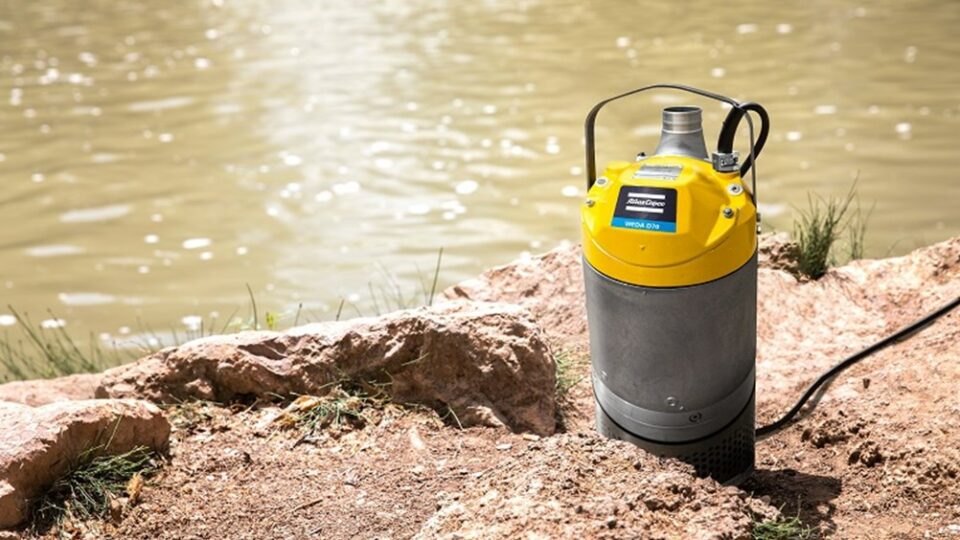The benefits of moving towards greener technologies are known to bring significant business advantages to operators. Here, we look at how renewable energy and the latest technologies can help constructors introduce greater sustainability and optimise operations.

Atlas Copco’s submersible dewatering pump WEDA-D70.
Sustainability continues to be a hot topic in the construction industry as it accounts for approximately 23% of the world’s total CO2 emissions (Bellona 2019), but green operation has traditionally not been the main objective for constructors. Cost-control and efficiency have, for a good reason, guided project planning and execution in the past. However, growing awareness of the effects of global warming has put construction as well as other machine-heavy industries under the spotlight, leading to the introduction of tighter regulations, such as Stage V.
Undoubtedly, the pressure to reduce emissions is high. Yet, at the same time, the need to improve operational efficiency is higher than ever. Fortunately, these two goals can be complementary. Many technologies already available are targeting sustainability while delivering better efficiency and contributing to a lower total cost of ownership (TCO) than traditional alternatives.
Significant savings
Pumps found on many construction sites can deliver significant savings, both in terms of CO2 emissions and TCO. Some environmentally conscious constructors are already taking advantage of the latest technologies to reduce the operational impact of the machines. Some manufacturers have introduced new and complementary technologies to make the use of pumps more efficient.
Atlas Copco, for example, has made the Wear Deflector an integral part of the design of its WEDA D70 range of electric submersible dewatering pumps. This hydraulic design reduces the size of the pump by up to 40% while contributing to a high level of pump efficacy and long life, even in challenging operating conditions, resulting in a low TCO.
Digital technologies, such as Atlas Copco’s FleetLink, can help further improve monitoring and assist operators in working more efficiently. FleetLink enables remote monitoring of pump performance and condition, providing the operational insight needed to optimise pump usage and maintenance. Tools like this can help keep equipment in optimal condition and eliminate any excess emissions resulting from potential malfunction while ensuring a continuous, cost-effective operation. This telematics system is included in Atlas Copco’s PAS HardHat Stage V dewatering pumps, empowering operators to reduce emissions because they are certified to work with HVO, the newest generation of biodiesel oil, to reduce the carbon footprint of the product itself.
Cleaner energy
Power generation is an area primarily dominated by diesel generators. Recent developments in high-density lithium-ion battery energy storage solutions provide operators with a simple way of addressing sustainability by complementing the generator’s power with energy stored from renewable sources.
Although the energy storage systems are not designed to replace a generator, they can facilitate smart load management, making generators more efficient, flexible, and quiet to operate. The technology helps operators address many of the challenges of remote construction sites where grid power is unavailable and city centre locations where emissions’ (CO2, NOx, and noise) limitations are imposed.
Energy storage systems are also key in reducing the size of the generator required. Some common construction equipment, such as cranes, rely on a significant power surge to get started yet consume little power for the rest of the shift, leading operators to choose an oversized generator to provide those few seconds of peak power. With li-ion battery energy storage systems, the batteries are used to meet the peak power requirement.
When power requirements are lower, the generator will power the load during the rest of the time. By using a hybrid solution, constructors can provide the required power but reduce the negative aspects of using an unnecessarily large generator, including excess emissions, black smoke, and noise. Further, operators can improve sustainability, cut costs and the battery system can also help extend the lifespan of the generator while optimising its performance.
Towards a better future
As these examples demonstrate, introducing low-emission technologies to a construction site can be simple, and also work towards zero emissions’ operations. Reducing CO2 emissions is good for the planet as well as the brand image and customer relationships. By demonstrating awareness of the environmental impact of construction and, more importantly, the willingness to address it, forward-thinking constructors can shape the industry towards a more sustainable future. This change can also bring significant benefits to the business: renewable energy sources deliver low-cost or even free energy, while more energy-efficient machines tend to consume less power, be easier to move around, and emit less smoke and noise.
When the rewards of choosing greener technologies include improved operation, lower TCO, and a healthier workplace, introducing a greater level of sustainability to the construction site should be on the agenda for every business.


